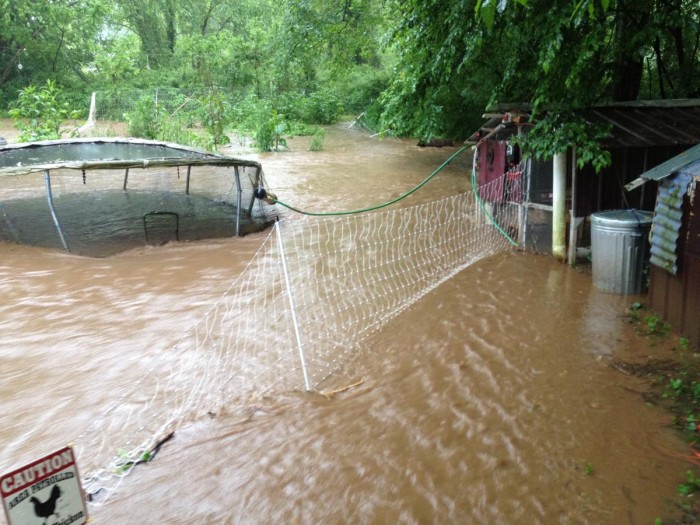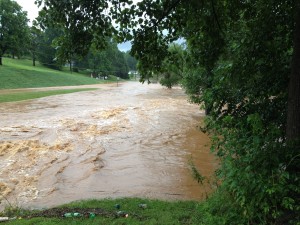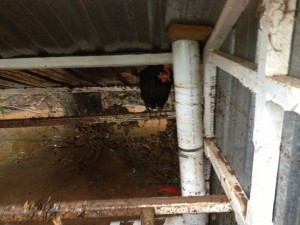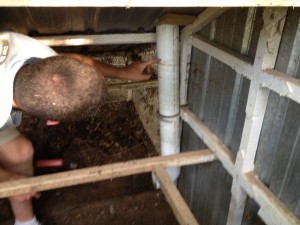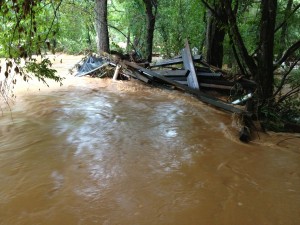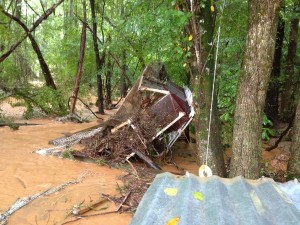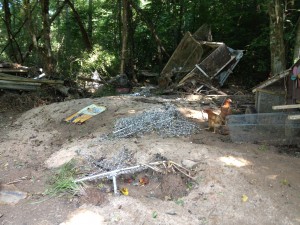Sometimes egg customers want to know what kind of chickens we have. We refer to them as “Rainbow Chickens,” because we have several different types. Here’s an article about why there are different kinds of chickens, and why we have selected the ones that we have.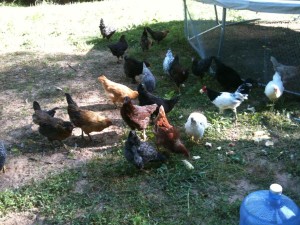
In the Beginning
The domestic chickens that we think of are said to be the great-great-manymoregreat-grand chickens of a particular type of jungle fowl. Over the many years, people domesticated them and began to selectively breed for traits that they liked.
A discussion about breeding and genetics should start with a discussion about the “birds and the bees” as they say. When a rooster and a hen love each other very much… well, let’s just skip to the part about genes. Hopefully everyone knows that when an offspring is created from the genes of two parents, the offspring will be similar in some ways to both parents, and different in some ways from both parents. What is less intuitive is how this relates to real life. For example, if you love Pink Lady apples and would like to grow your own (disregarding the trademark infringement issue) you might try planting the seeds that came from an apple that you purchased from the store.
 The problem with that strategy is that the seeds will produce offspring, not parents. You see, when the boy parts of an apple tree and the girl parts of another apple tree love each other very much, they get together and hire a bee (for the small fee of a drink of nectar) to carry genetic material from the boy parts to the girl’s flower. The site of the flower then becomes an apple, which carries the genetic material of the offspring in its seeds. That offspring will be a new-to-the-world apple. This is why there are anywhere from 7500 to 40,000 different named apple varieties, depending on who you ask.
The problem with that strategy is that the seeds will produce offspring, not parents. You see, when the boy parts of an apple tree and the girl parts of another apple tree love each other very much, they get together and hire a bee (for the small fee of a drink of nectar) to carry genetic material from the boy parts to the girl’s flower. The site of the flower then becomes an apple, which carries the genetic material of the offspring in its seeds. That offspring will be a new-to-the-world apple. This is why there are anywhere from 7500 to 40,000 different named apple varieties, depending on who you ask.
When it comes to people and chickens, the same is true. Would you expect that your best friend’s kid would grow up to be your best friend also? Maybe, or maybe not. You’d expect that your best friend’s kid might have some similarities to your best friend, or at least the UPS guy, but they aren’t going to be identical. The kid might be very awesome, or might be a total jerk. This is where the apple analogy falls away from the discussion, because apple trees can be vegetatively propagated, meaning that a cutting from one tree can be grafted to produce a genetic clone of the parent. So far, our society has not considered it ethical to apply this technology to humans. The verdict is still out on the public opinion of cloning domesticated livestock. Industrial producers who strive for a consistent product tend to be quite in favor of it.
Getting Back to Chickens
We humans use chickens for several purposes, and different chickens have different traits that better suit them for each of those purposes. The traits are often mutually exclusive. For example, a chicken that is a very good egg layer is probably not going to be as good of a chicken to eat. The egg layer is going to have a slim body type, sending more of the inputs into egg production and less into increasing body weight. The meat bird is going to look like a body builder, and cluck with a deep voice. That case seems obvious enough, but there are plenty of other traits that matter too. For example, a producer who keep a chicken in a giant building with 19,999 other chickens would prefer that the birds be as inactive as possible. If those chickens are walking, scratching, flapping, or playing cards, they are burning calories that have to be replaced by food. Food is neither inexpensive nor free. That activity increases the temperature and humidity, which is insignificant until it is multiplied by 20,000. Then those must be mitigated by systems that are priced similarly to feed. He wants a bird that will just sit there, eat, and convert as much of that food as possible into meat.
In contrast, someone who has a free-range chicken wants that bird to be active. It needs to be out in the yard scratching, digging, and looking for bugs to eat. Naturally-occurring insects are both free and inexpensive, and when chickens are eating them, they are getting a diverse diet with nutrients that may not be found in the feed that they may have access to. And they are eating less of that feed! The free-range chicken needs to be able to defend itself, getting out of the way of predators.
Apply this concept to each of the hundreds of traits that you might like to think of, such as egg shape, shell color, feather type and color, color patterns, tendency to want to raise offspring or not (go broody, as we say), body size, hardiness (disease resistant without medication), skin color, foot color, temperament (tame vs wild), and you can see that there are many things to choose from. What about the ability to tell hens from roosters on the day that they hatch? That sure could be handy. The more of these traits that a breeder selects, the less likely he is to be able to excel in all of them.
Say that a breeder wants a flock that is active and hardy, with good egg and meat production, with gold and black feathers. He can do that; it might take a few decades, but he could produce his ideal chicken. It would not be a breed listed in the APA’s Standard of Perfection, but he might try to change that. It would be almost certain that while his chickens would be better at laying eggs than a specialized meat bird, and better at meat production than a specialized egg bird. It would be equally certain that they would not be as good at meat production as a specialized meat bird, etc. You get the idea.
Getting to the Standard, Named Breeds
When we tell you that we have two Rhode Island Red hens (as of 6/2015) for example, you know what that means. The Standard of Perfection has a listing for that breed, which includes a detailed description of the type. Folks who go to poultry shows will bring the bird that they think most conforms to that description, and the judges will bestow awards on the birds that the judge feels most conform. Then breeders can ask higher prices for the eggs from those award winners. If, for example, a breeder knows that his birds generally conform very well on feathering and foot color, but fall short on comb type, she might make some changes. Maybe she’ll get in touch with another breeder who has birds with more conforming combs, and hatch some of his eggs. Over time, she can use a mixture of art and science to produce a line of chickens that will win awards for conforming to the standard.
This is not what we do. Not that we have anything against those who do, it’s just that breeding and showing is a separate hobby. Our late friend James Keeton was able to make significant money at it in the early 1900s in fact. Many of our chickens are what we call “easter eggers,” because they are descendants of a few different breeds. They have been bred with emphasis on egg laying and hardiness traits instead of conformation to a standard. As such, they don’t really have an official breed name.
Rainbow Chickens, Finally
We refer to our flock as “rainbow chickens.” Our flock perfectly serves our own priorities, which include that each member is, for example:
- Active and foraging
- Hardy and healthy
- Tame enough to handle
- An active layer
- Comfortable in our climate
- Not a risk to the others
None of those priorities lead us to a particular breed, or even a named breed. In fact, our preference is that each egg carton has a rainbow variety of egg types and shell colors, so an additional priority is that our chickens come from different breeds. As of today, half of our flock includes Barred Rocks, Buff Orpingtons, and Rhode Island Reds. The other half includes the easter eggers, one mixed rock that we call “dirty bird,” one mixed Black Ostralorp and Welsummer, one half welsummer and half easter egger, etc. We have two roosters for predator mitigation. One is half easter egger and half Dark Brahma, and the other is half of that mix and half Welsummer and Black Ostralorp.
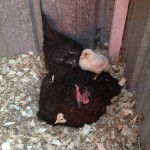 Many of our mixed breeds came from our own hatchings. In fact, if we were to only sustain our flock by hatching our own eggs, our flock would eventually homogenize. It might take several decades, but they would settle in as a previously unknown breed, all with similar egg colors (olive green), and who knows what kind of feathers. These little mongrels would still do what we prefer on the whole, especially if we were to only hatch the eggs of the parents that we liked, but they would definitely not be a recognized breed.
Many of our mixed breeds came from our own hatchings. In fact, if we were to only sustain our flock by hatching our own eggs, our flock would eventually homogenize. It might take several decades, but they would settle in as a previously unknown breed, all with similar egg colors (olive green), and who knows what kind of feathers. These little mongrels would still do what we prefer on the whole, especially if we were to only hatch the eggs of the parents that we liked, but they would definitely not be a recognized breed.
We keep chickens primarily for entertainment and education, with egg sales just being a means to offset the cost of feed. (There are certainly more productive ways for us to make money!) Since we enjoy our chickens more when we can appreciate them as individuals, having different types also allows us to more easily keep track of which one is which. So having the rainbow also meets our needs in that sense, making the flock more interesting. Breeding and perfecting a particular line of chickens is hard work. The chickens almost certainly have to be confined, or at least separated from each other somehow. For us, it’s just not worth the trouble, because that’s not what we think of as fun.
There you have it, more than you probably ever wanted to know about why we call the hens at the Happy Egg Farm “Rainbow Chickens.” Leave us a comment about what kind of traits you like to see in chickens!
 Happy Egg Farm
Happy Egg Farm